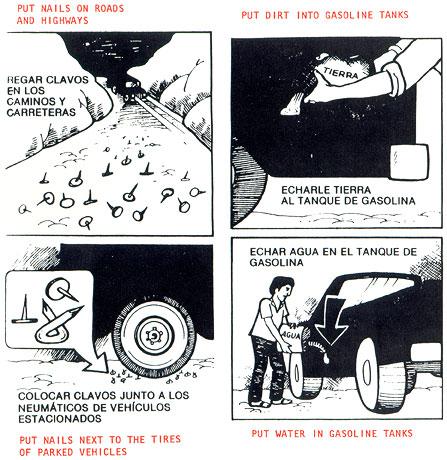Nicaragua 1982-88

CIA instruction manual for sabotage activities against the Sandinista regime
What we might call the exile raiding syndrome was most fully on display in the 1980s, when the U.S. tried to reacquire Nicaragua as a client state. Elsewhere on the website, there is an account of how the U.S. attempted to find a so-called third force that would prevent the Sandinistas from taking over after the fall of Somoza. Within two weeks after Somoza had fled the country, Carter authorized the first of a series of covert political operations aimed at delegitimating the Sandinistas and hampering whatever military ties they might be establishing with Cuba . When Reagan came into office, he considerably stepped up these efforts. By then, a nucleus of former National Guard troops was across the border in Honduras , being trained by Argentinian officers. In late 1981, Reagan approved an 11-point program for “Cuba and Central America,” a key point of which was to carry out political and paramilitary operations “against the Cuban presence and Cuban-Sandinista support infrastructure in Nicaragua and elsewhere in Central America.” An accompanying CIA “scope” paper specified that this would involve the “formation and training of action teams” which would be “primarily” non-U.S. in nature; the aim of these teams' paramilitary activities would, in the words of the formal presidential “finding,” be “to facilitate” a new regime in Nicaragua. The CIA immediately went to work, building up the exiles (“contras”) into a force of close to 7,000 men which soon began to launch raids across the Honduran border.
Within a few months, word of the operation had leaked out, and U.S. newspapers and magazines had begun to print stories about how the contras intended to march into Managua and depose the Sandinistas. This caused a political problem, because the administration had told Congress its aim was only to interdict military supplies supposedly going from Nicaragua to the FMLN rebels in El Salvador (see chapter five of the book). Congress's reaction, occasioned by both institutional pride and concern that large-scale contra attacks could suck the U.S. into fighting a counterinsurgency war against the Sandinistas, was to pass legislation first restricting U.S. aid to the contras, then forbidding it altogether, an action Reagan attempted to counteract by soliciting funds from other countries and private donors. By then, U.S. support for the contras had become an open secret, with Reagan himself admitting it and defending it in hyperbolic language. Over the next few years, even as contra military operations stagnated at a low level, aid for them became a political football in Washington , with shifting majorities restoring it, then cutting it off again. During this time, the contras' fecklessness became clear to even their strongest supporters in Washington : for example, a high-ranking CIA official flatly concluded that “even with American support,” they would be unable to “overthrow the Sandinista regime.” The U.S. general who had been in charge of Southern Command dismissed them as “a cross-border raiding force” with no chance of “knock[ing] off the Sandinistas.” In addition, the contras routinely engaged in violence against the very civilians they were supposedly trying to woo, thereby making it even harder for them to carry out sustained guerrilla operations. None of this seemed to matter to Reagan and his aides, who continued to press for both “lethal” and “nonlethal” aid to the contras. What finally ended the operation was the Nicaraguan election of 1990, when the Sandinistas, drained by a decade of war, were, to everyone's surprise, voted out of office. 1
1) “National Security Decision Directive on Cuba and Central America,” NSDD 17, 4 January 1982 (ProQuest 2005), with wording on pt. 10 from “Reagan Backs Action Plan for Central America” and “U.S.-Backed Nicaraguan Rebel Army Swells to 7,000 Men,” both Washington Post , 14 February 1982, 8 May 1983, and CIA scope paper of mid-November 1981 from latter article and “U.S. Said to Plan Covert Actions in Latin Region,” New York Times , 14 March 1982; Finding and Scope, NSC/ICS 03340, 1 December 1981, Tab II of Gregg to Clark, “Proposed Covert Action Finding on Nicaragua,” 12 July 1982 (ProQuest 2005); Gates to Casey, “Nicaragua,” 14 December 1984 (Kornbluh and Byrne 1993: doc. 15; Gorman before Senate Armed Services Committee, 28 January 1987, quoted in “Carlucci Taking Trip to Evaluate Contras; Rebels Can't Win, Military Expert Asserts,” Washington Post , 29 January 1987; also Woodward (1987); Gutman (1988); Gates (1996: 150-3); LeoGrande (1998). Two additional means of financing involved diversion of profits from the secret sale of arms to Iran (this so-called diversion was at the heart of the Iran-contra scandal in 1987-87), and participation in cocaine smuggling from Colombia (McCoy 2003: 487-500). As regards the ending of aid to the contras, it is worth noting that when Bush took over from Reagan, he continued pushing for aid; it is hard to say whether he would have given up had the Sandinistas won the 1990 elections. Even a decade and a half later, the U.S. was still acting against the Sandinistas, this time in the electoral arena: “ US Warns Nicaraguans Not To Back Ortega,” Financial Times , 14 September 2006.
